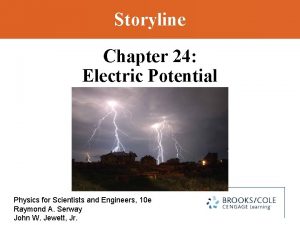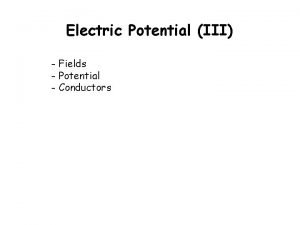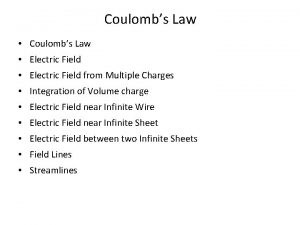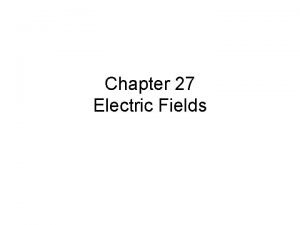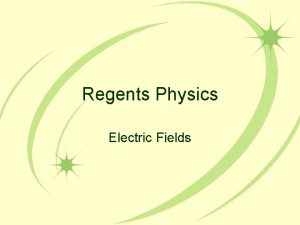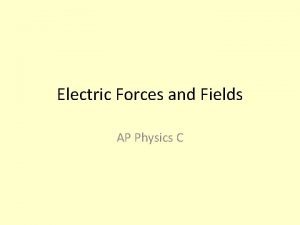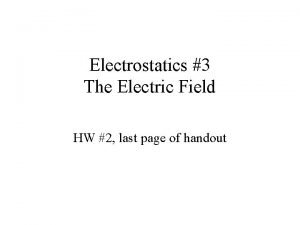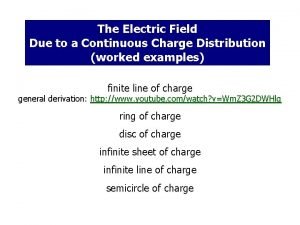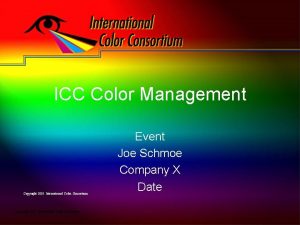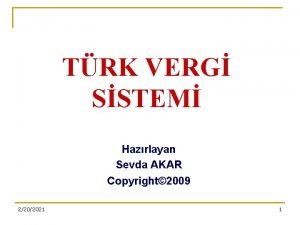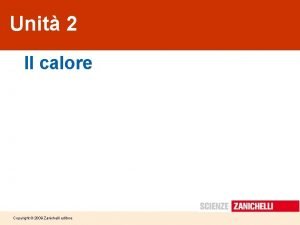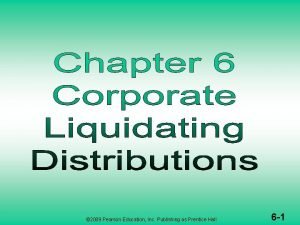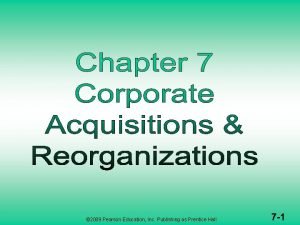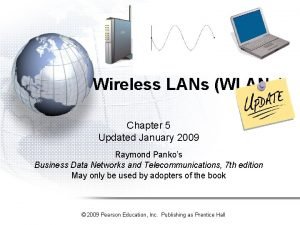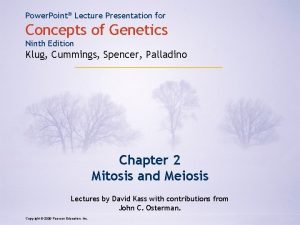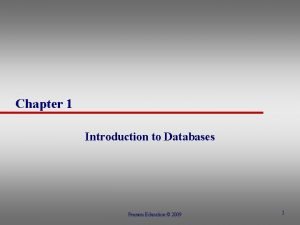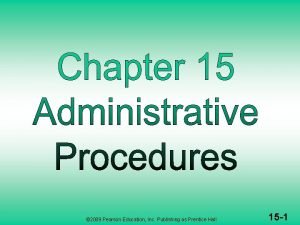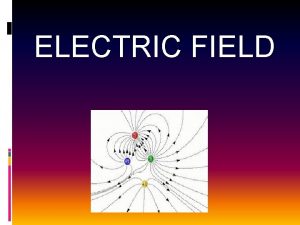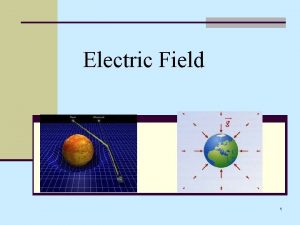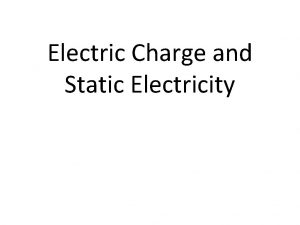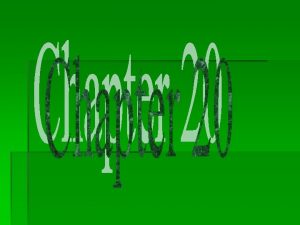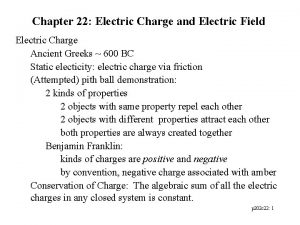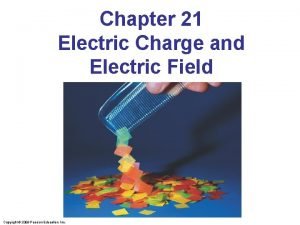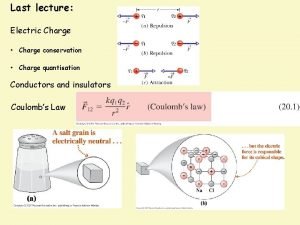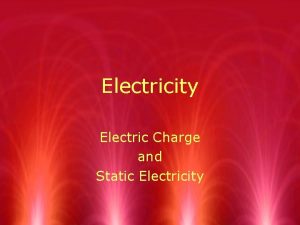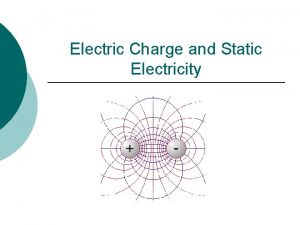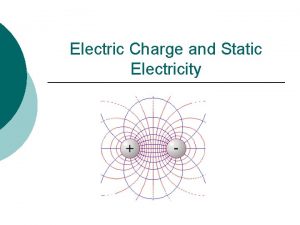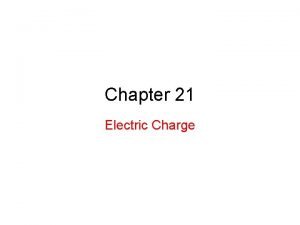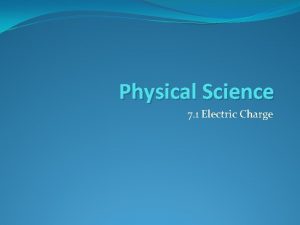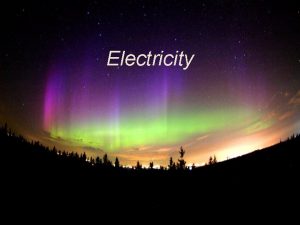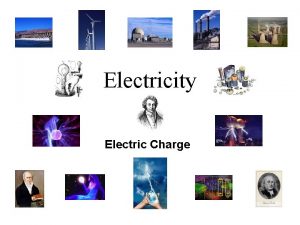Electric Charge and Electric Field Copyright 2009 Pearson





















































- Slides: 53

Electric Charge and Electric Field Copyright © 2009 Pearson Education, Inc.

Charged Particles Copyright © 2009 Pearson Education, Inc.

Objects can be charged by rubbing How does a Carbon atom get a plus one charge? How does a Carbon atom get a minus two charge? Copyright © 2009 Pearson Education, Inc.

The standard unit of charge is much bigger. It is called a coulomb which consists of 6. 24 x 1018 Charge on the electron: e = 1. 602 x 10 -19 C. Electric charge is quantized in units of the electron charge. Copyright © 2009 Pearson Education, Inc.

Example: Find the number of coulombs of charge on 50 electrons. Example: Find the number of charges in 30 n. C. Copyright © 2009 Pearson Education, Inc.

Static Electricity; Electric Charge and Its Conservation Charge comes in two types, positive and negative; like charges repel and opposite charges attract. Copyright © 2009 Pearson Education, Inc.

Static Electricity; Electric Charge and Its Conservation Electric charge is conserved – the arithmetic sum of the total charge cannot change in any interaction. Copyright © 2009 Pearson Education, Inc.

Insulators and Conductors Conductor: Insulator: Charge flows freely Almost no charge flows Metals Most other materials Copyright © 2009 Pearson Education, Inc.

Example: Draw what happens to the two boxes below after they are touched together. Copyright © 2009 Pearson Education, Inc.

Charge by Conduction Metal objects can be charged by conduction: Copyright © 2009 Pearson Education, Inc.

Charge by Friction Scraping insulators together can do work and excite electrons. This may move them from one material to another. Copyright © 2009 Pearson Education, Inc.

Induced Charge Nonconductors won’t become charged by conduction or induction, but will experience charge separation. Copyright © 2009 Pearson Education, Inc.

Induced Charge They can also be charged by induction, either while connected to ground or not: Copyright © 2009 Pearson Education, Inc.

Copyright © 2009 Pearson Education, Inc.

Induced Charge; the Electroscope The electroscope can be used for detecting charge. Copyright © 2009 Pearson Education, Inc.

Induced Charge; the Electroscope The charged electroscope can then be used to determine the sign of an unknown charge. Copyright © 2009 Pearson Education, Inc.

Example: Draw the leaves and charge distribution for each electroscope below. Copyright © 2009 Pearson Education, Inc.

Coulomb’s Law Experiment shows that the electric force between two charges is proportional to the product of the charges and inversely proportional to the distance between them. and Copyright © 2009 Pearson Education, Inc.

Coulomb’s Law Coulomb’s law: This equation gives the magnitude of the force between two charges. Copyright © 2009 Pearson Education, Inc.

Coulomb’s Law The force is along the line connecting the charges, and is attractive if the charges are opposite, and repulsive if they are the same. Copyright © 2009 Pearson Education, Inc.

Coulomb’s Law Unit of charge: coulomb, C. The proportionality constant in Coulomb’s law is then: k = 9 x 109 N·m 2/C 2. Charges produced by rubbing are typically around a microcoulomb: 1 μC = 10 -6 C. Copyright © 2009 Pearson Education, Inc.

Example: Calculate the force between two clouds that each have a charge of 3 C and are 600 m apart. Copyright © 2009 Pearson Education, Inc.

Example: Calculate the force between a helium nucleus and an electron that are 2 x 10 -10 m apart. Copyright © 2009 Pearson Education, Inc.

Electric Field Copyright © 2009 Pearson Education, Inc.

Van De Graaff Copyright © 2009 Pearson Education, Inc.

Electric Field + Copyright © 2009 Pearson Education, Inc. -

The Electric Field An electric field surrounds every charge. Copyright © 2009 Pearson Education, Inc.

Field Lines The electric field can be represented by field lines. These lines start on a positive charge and end on a negative charge. Copyright © 2009 Pearson Education, Inc.

Field Lines Electric dipole: two equal charges, opposite in sign: Copyright © 2009 Pearson Education, Inc.

Electric Field Copyright © 2009 Pearson Education, Inc.

Field Lines The electric field between two closely spaced, oppositely charged parallel plates is constant. Copyright © 2009 Pearson Education, Inc.

Field Lines The electric field between two closely spaced, oppositely charged parallel plates is constant. Copyright © 2009 Pearson Education, Inc.

Example: Draw the electric fields for the charge distributions below + - ++++++++ ----------- + Copyright © 2009 Pearson Education, Inc. +

Field Lines Summary of field lines: 1. Field lines indicate the direction of the field; the field is tangent to the line. 2. The magnitude of the field is proportional to the density of the lines. 3. Field lines start on positive charges and end on negative charges; the number is proportional to the magnitude of the charge. Copyright © 2009 Pearson Education, Inc.

Electric Field Inside Conductors Copyright © 2009 Pearson Education, Inc.

Faraday Cage EMV Cards Mythbusters RFID Crazy Person Trash Can Copyright © 2009 Pearson Education, Inc.

The Electric Field The electric field is defined as the force on a small charge, divided by the magnitude of the charge: Copyright © 2009 Pearson Education, Inc.

The Electric Field Example: Find the electric field in a region where a proton feels a force of 20 m. N. Copyright © 2009 Pearson Education, Inc.

The Electric Field For a point charge: Copyright © 2009 Pearson Education, Inc.

The Electric Field Example: Find the electric field created by an isolated 1 m. C charge at a distance of 1 cm. Copyright © 2009 Pearson Education, Inc.

Potential Difference • Voltage finds the work done per unit charge and is written: V = W/q • The standard units for this are of course Joules per coulomb but it is more commonly called Volts. Copyright © 2009 Pearson Education, Inc.

Waterfall Analogy • Taller Waterfall- More Change in PE • More Water- More electrons Copyright © 2009 Pearson Education, Inc.

Example: Find the work needed to move 6 C through a 15 V potential difference. Copyright © 2009 Pearson Education, Inc.

Example: What is the energy required to move one electron through a 3 V potential drop? How else can this be expressed? Copyright © 2009 Pearson Education, Inc.

Millikan Oil Drop • Oil floats at certain heights. Charge exists in certain amounts. Copyright © 2009 Pearson Education, Inc.

Millikan Graph Copyright © 2009 Pearson Education, Inc.

Photocopy Machines and Computer Printers Use Electrostatics Copyright © 2009 Pearson Education, Inc.

Photocopy Machines and Computer Printers Use Electrostatics Laser printer is similar, except a computer controls the laser intensity to form the image on the drum. Copyright © 2009 Pearson Education, Inc.

Equipotential Surfaces A gravitational analogy to equipotential surfaces is the topographical map – the lines connect points of equal gravitational potential (altitude). Copyright © 2009 Pearson Education, Inc.

Contour Map Copyright © 2009 Pearson Education, Inc.

Equipotential Surfaces While electric fields are the most common way to draw the interaction around charged objects it can be helpful to understand the equipotential surfaces as well. Copyright © 2009 Pearson Education, Inc.

Equipotential Surfaces An equipotential is a line or surface over which the potential is constant. Electric field lines are perpendicular to equipotentials. The surface of a conductor is an equipotential. Copyright © 2009 Pearson Education, Inc.

Capacitors A capacitor consists of two conductors that are close but not touching. A capacitor has the ability to store electric charge. Copyright © 2009 Pearson Education, Inc.
 Chapter 21 electric charge and electric field
Chapter 21 electric charge and electric field Chapter 21 electric charge and electric field
Chapter 21 electric charge and electric field K constant unit
K constant unit Dc o/d per item charge
Dc o/d per item charge Copyright 2009 pearson education inc
Copyright 2009 pearson education inc Copyright 2009 pearson education inc
Copyright 2009 pearson education inc Copyright 2009 pearson education inc
Copyright 2009 pearson education inc 2009 pearson education inc
2009 pearson education inc Copyright 2009 pearson education inc
Copyright 2009 pearson education inc 2009 pearson education inc
2009 pearson education inc Difference between charge and electric charge
Difference between charge and electric charge Difference between static and current electricity
Difference between static and current electricity 21lwuy8i6hw -site:youtube.com
21lwuy8i6hw -site:youtube.com Q factor of capacitor
Q factor of capacitor Difference between electric field and magnetic field
Difference between electric field and magnetic field Electric field of a finite line charge
Electric field of a finite line charge Electrostatics equations
Electrostatics equations Electric field of a finite line charge
Electric field of a finite line charge Sheet of charge electric field
Sheet of charge electric field Electric field at a point formula
Electric field at a point formula Electric field si units
Electric field si units Electric field lines about a point charge extend
Electric field lines about a point charge extend Electric field of line charge
Electric field of line charge Force on charge in electric field
Force on charge in electric field Electric field due to a continuous charge distribution
Electric field due to a continuous charge distribution Energy in an electric field
Energy in an electric field Electric potential electric field
Electric potential electric field What is electric potential
What is electric potential Electric potential vs electric potential energy
Electric potential vs electric potential energy International colour consortium
International colour consortium Dell all rights reserved copyright 2009
Dell all rights reserved copyright 2009 Diffrazione della luce zanichelli
Diffrazione della luce zanichelli Copyright 2009
Copyright 2009 Capacita termica
Capacita termica 2009 pearson education inc
2009 pearson education inc 2009 pearson education inc
2009 pearson education inc 2009 pearson education inc
2009 pearson education inc Pearson 2009
Pearson 2009 Pearson 2009
Pearson 2009 Pearson 2009
Pearson 2009 Pearson education 2009
Pearson education 2009 2009 pearson education inc
2009 pearson education inc 2009 pearson education inc
2009 pearson education inc 2017 pearson education inc
2017 pearson education inc Copyright pearson education inc
Copyright pearson education inc Copyright 2010 pearson education inc
Copyright 2010 pearson education inc 2018 pearson education inc
2018 pearson education inc 2014 pearson education inc
2014 pearson education inc Copyright 2010 pearson education inc
Copyright 2010 pearson education inc Copyright 2010 pearson education inc
Copyright 2010 pearson education inc Copyright by pearson education inc. answers
Copyright by pearson education inc. answers 2008 pearson education inc
2008 pearson education inc 2005 pearson prentice hall inc
2005 pearson prentice hall inc 2015 pearson education inc
2015 pearson education inc















